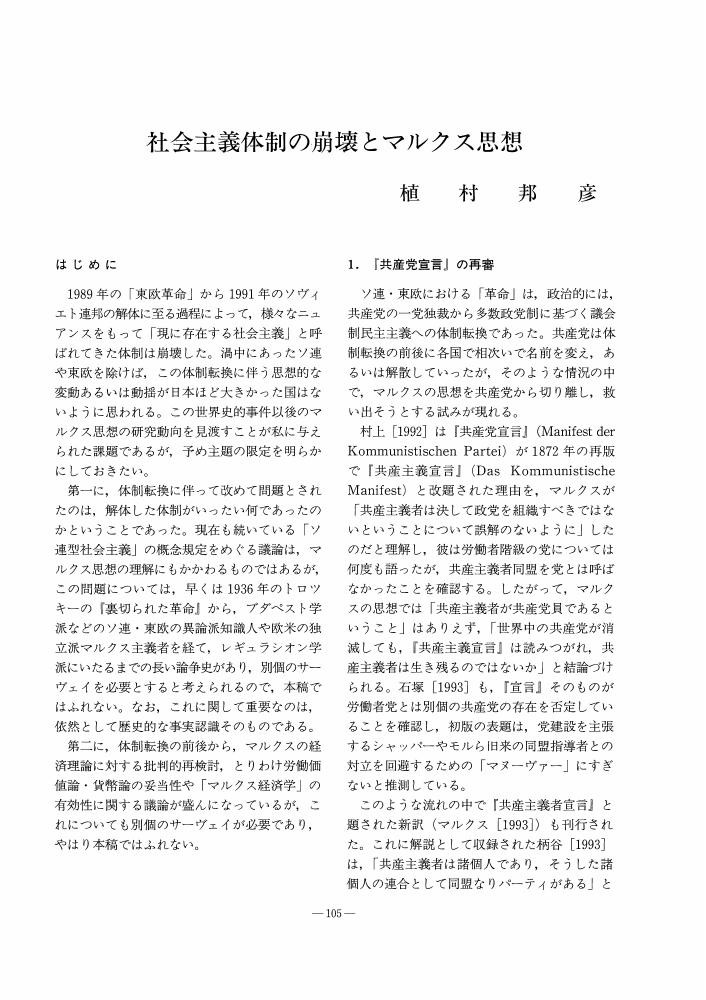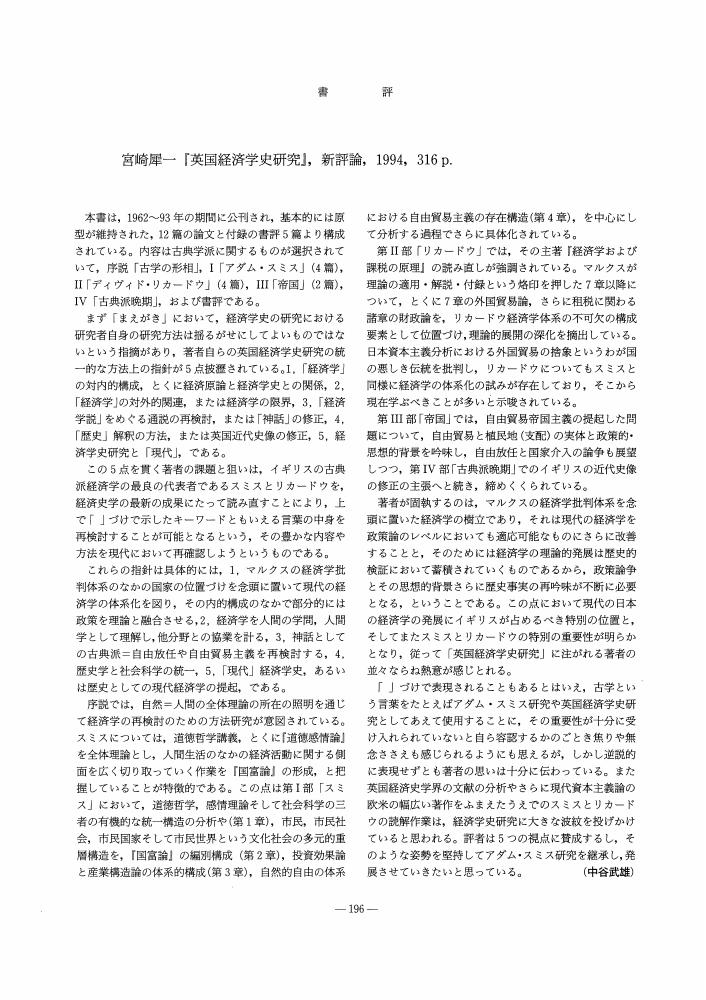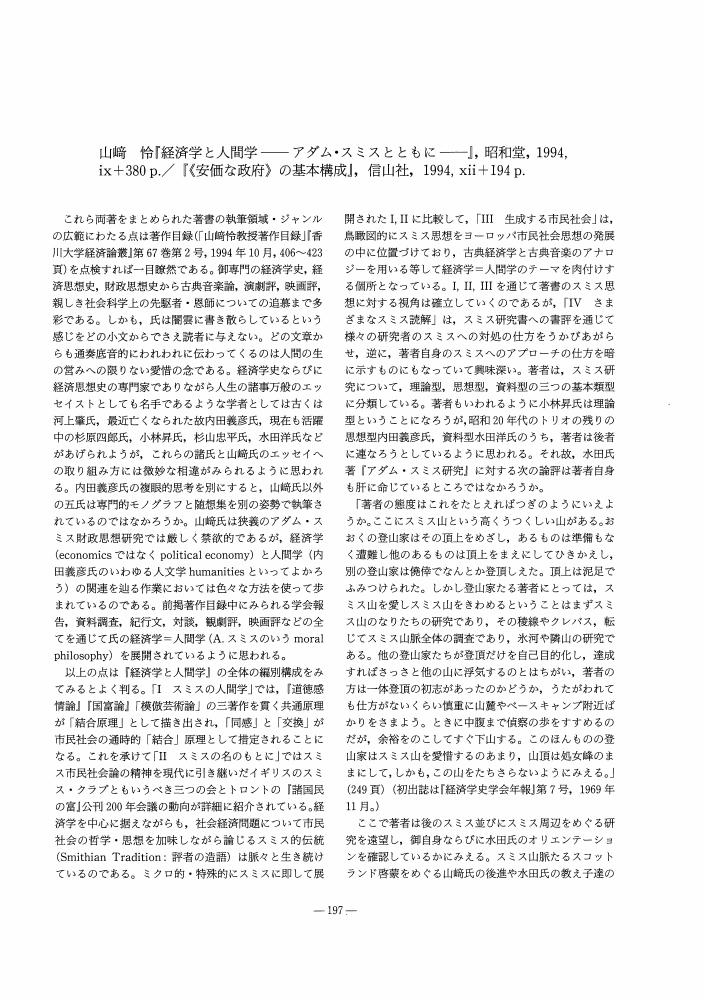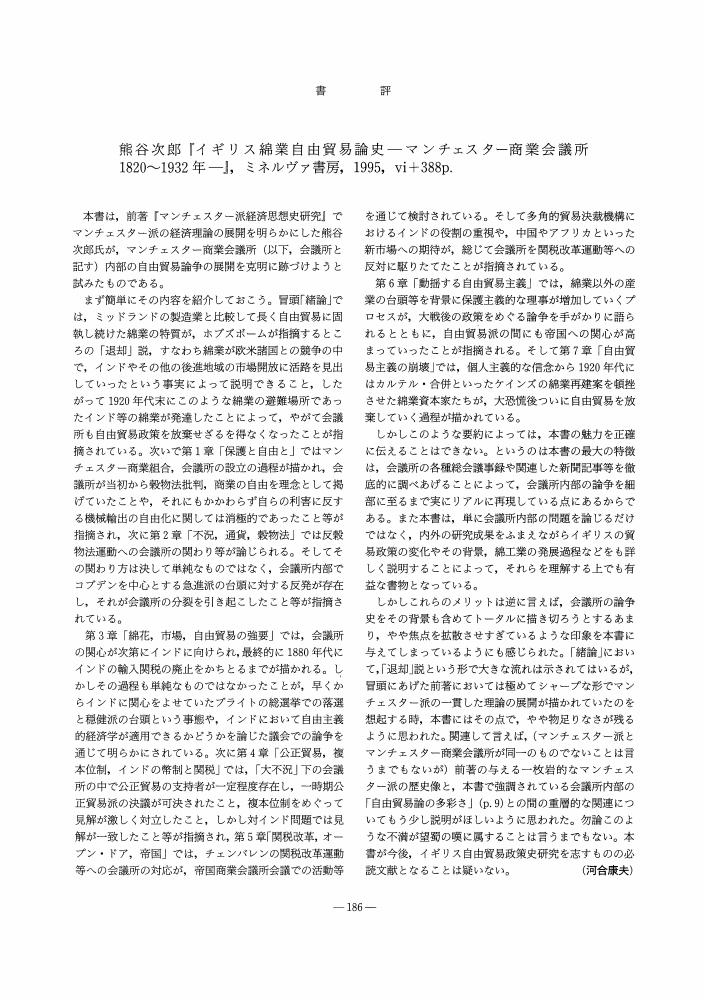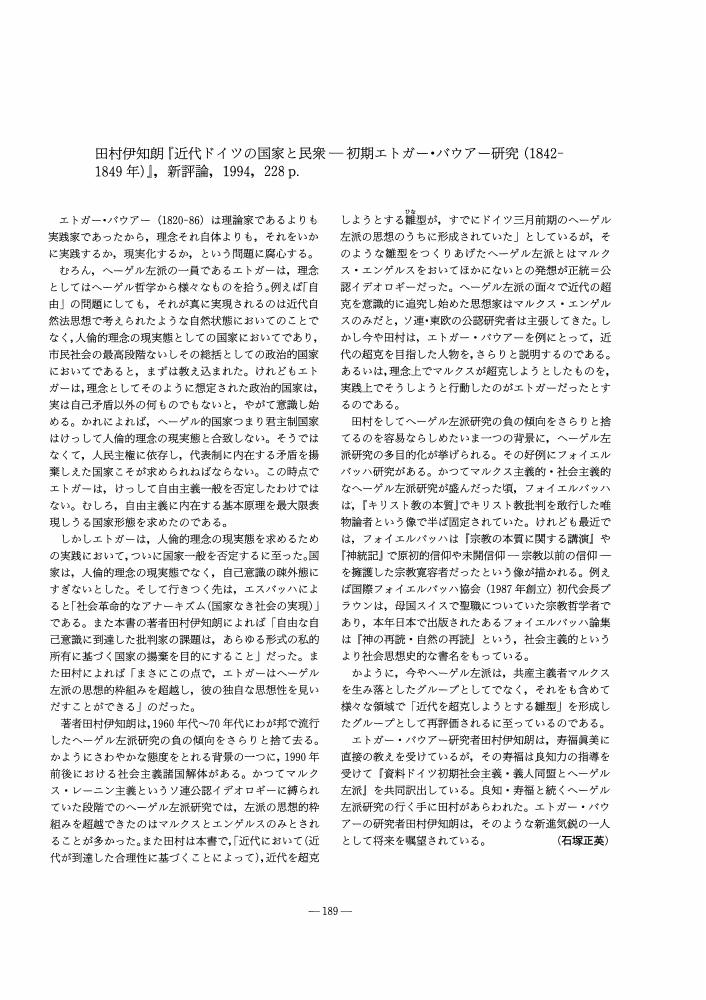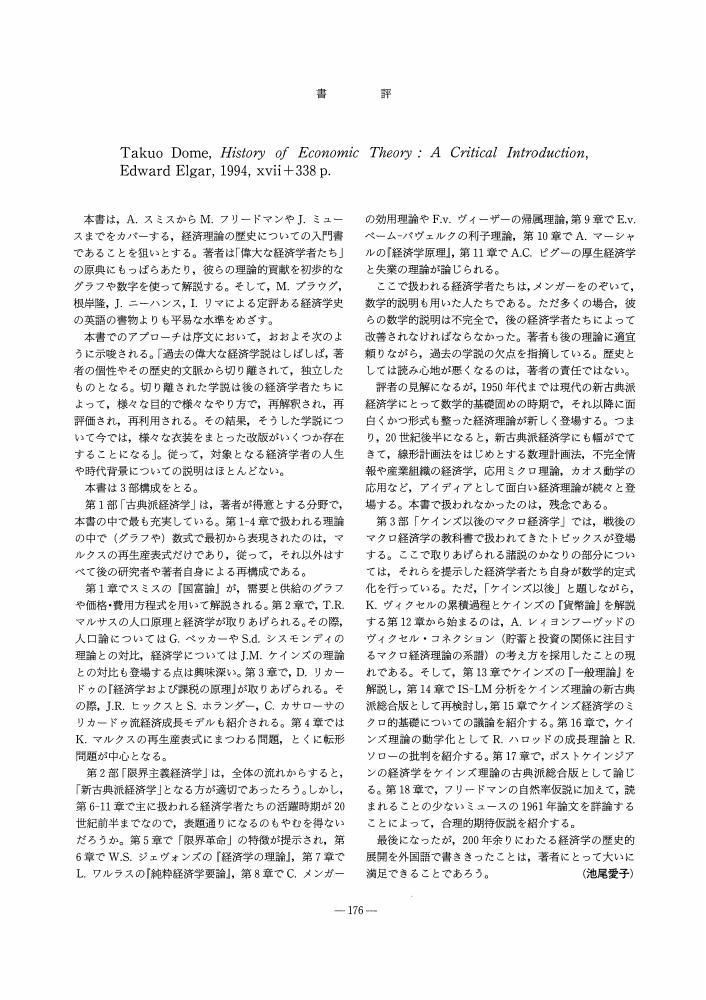1 0 0 0 OA マーシャル『産業と商業』の動態論
- 著者
- 藤井 賢治
- 出版者
- The Japanese Society for the History of Economic Thought
- 雑誌
- 経済学史学会年報 (ISSN:04534786)
- 巻号頁・発行日
- vol.34, no.34, pp.77-88, 1996 (Released:2010-08-05)
- 参考文献数
- 27
The economics of Marshall has long been assessed mainly on The Principles of Economics; besides, the assessment centered on the partial-equilibrium aspect of it. Although Marshall himself recommended and pursued a biological economics, his attempt has been evaluated as merely a promise. This paper examines Industry and Trade, which has practically been ignored as far as its theoretical aspect is concerned. One can find ‘standardization’ plays the key role in the historical accounts of that book. ‘Standardization’ which means more common knowledge possessed by members of an organization, is caused by habitual behaviours of agents or institutional arrangements agreed upon and promotes the development of that organization, thereby increasing the productivity of it. ‘Standardization’ captures an interaction of men and environments in an economic sense and provides Marshallian economics with the dynamics necessary for organizational growth.
1 0 0 0 OA 社会主義体制の崩壊とマルクス思想
- 著者
- 植村 邦彦
- 出版者
- The Japanese Society for the History of Economic Thought
- 雑誌
- 経済学史学会年報 (ISSN:04534786)
- 巻号頁・発行日
- vol.34, no.34, pp.105-111, 1996 (Released:2010-08-05)
- 参考文献数
- 42
1 0 0 0 OA 〈社会経済システムの制度分析〉に向けて
- 著者
- 磯谷 明徳
- 出版者
- The Japanese Society for the History of Economic Thought
- 雑誌
- 経済学史学会年報 (ISSN:04534786)
- 巻号頁・発行日
- vol.34, no.34, pp.1-13, 1996 (Released:2010-08-05)
- 参考文献数
- 50
The object of this paper is to examine various developments in ‘the Economics of Institutions’ since the 1970s and to make some comparisons between three kinds of institutionalism, that is, the ‘new’ institutional economics, paticularly of Willamson and North, the ‘modern’ institutional economics of Hodgson, and ‘the comparative institutional analysis’ of Aoki and Okuno. From these comparisons we reach three subjects to be further explored. The first point is that the core of the questions is the nature of the human agent and the scope for rationality. The second point is to construct an alternative theory of individual behavior to the neoclassical economist's assumption of maximizing behavior, related to the socio-economic context of social relations and institutions. The final point is to formulate the circular causation between the consciousness and action of the human agent (i. e., the microanalysis of the socio-economic system) and conventions, social norms and institutions (i. e., the macroanalysis of the socio-economic system). Following the conceptualization of Shiozawa, we call this circular causation the ‘micro-macro loop’. It is the analysis of this ‘micro-macro loop’ that is the most important for our approach to ‘the economics of institutions.’ Special emphasis should be laid on the loop of causation from ‘macro’ to ‘micro’ because the three kinds of institutional economics which have been examined here leave this loop untouched. We therefore conclude that ‘the economics of institutions’ should be a reproduction-theoretic analysis of the socio-economic system based on the investigations of the ‘mico-macro loop’ which is linked together with a set of institutions.
1 0 0 0 OA 星野彰男『市場社会の体系 -ヒュームとスミス-』, 新評論, 1994, 276p.
- 著者
- 篠原 久
- 出版者
- 経済学史学会
- 雑誌
- 経済学史学会年報 (ISSN:04534786)
- 巻号頁・発行日
- vol.33, no.33, pp.195, 1995 (Released:2010-08-05)
1 0 0 0 OA 宮崎犀一『英国経済学史研究』, 新評論, 1994, 316p.
- 著者
- 中谷 武雄
- 出版者
- 経済学史学会
- 雑誌
- 経済学史学会年報 (ISSN:04534786)
- 巻号頁・発行日
- vol.33, no.33, pp.196, 1995 (Released:2010-08-05)
- 著者
- 石井 信之 山崎 怜
- 出版者
- 経済学史学会
- 雑誌
- 経済学史学会年報 (ISSN:04534786)
- 巻号頁・発行日
- vol.33, no.33, pp.197-198, 1995 (Released:2010-08-05)
- 著者
- 塘 茂樹
- 出版者
- 経済学史学会
- 雑誌
- 経済学史学会年報 (ISSN:04534786)
- 巻号頁・発行日
- vol.33, no.33, pp.199-201, 1995 (Released:2010-08-05)
- 著者
- 音無 通宏
- 出版者
- 経済学史学会
- 雑誌
- 経済学史学会年報 (ISSN:04534786)
- 巻号頁・発行日
- vol.33, no.33, pp.185, 1995 (Released:2010-08-05)
- 著者
- 河合 康夫
- 出版者
- 経済学史学会
- 雑誌
- 経済学史学会年報 (ISSN:04534786)
- 巻号頁・発行日
- vol.33, no.33, pp.186, 1995 (Released:2010-08-05)
- 著者
- 水田 洋
- 出版者
- 経済学史学会
- 雑誌
- 経済学史学会年報 (ISSN:04534786)
- 巻号頁・発行日
- vol.33, no.33, pp.188, 1995 (Released:2010-08-05)
- 著者
- 石塚 正英
- 出版者
- 経済学史学会
- 雑誌
- 経済学史学会年報 (ISSN:04534786)
- 巻号頁・発行日
- vol.33, no.33, pp.189, 1995 (Released:2010-08-05)
- 著者
- 千賀 重義
- 出版者
- 経済学史学会
- 雑誌
- 経済学史学会年報 (ISSN:04534786)
- 巻号頁・発行日
- vol.33, no.33, pp.190, 1995 (Released:2010-08-05)
- 著者
- 田中 正司
- 出版者
- 経済学史学会
- 雑誌
- 経済学史学会年報 (ISSN:04534786)
- 巻号頁・発行日
- vol.33, no.33, pp.191, 1995 (Released:2010-08-05)
- 著者
- 荒牧 正憲
- 出版者
- 経済学史学会
- 雑誌
- 経済学史学会年報 (ISSN:04534786)
- 巻号頁・発行日
- vol.33, no.33, pp.192, 1995 (Released:2010-08-05)
- 著者
- 東 清二郎 橋本 努
- 出版者
- 経済学史学会
- 雑誌
- 経済学史学会年報 (ISSN:04534786)
- 巻号頁・発行日
- vol.33, no.33, pp.193-194, 1995 (Released:2010-08-05)
- 著者
- 原田 哲史
- 出版者
- The Japanese Society for the History of Economic Thought
- 雑誌
- 経済学史学会年報 (ISSN:04534786)
- 巻号頁・発行日
- vol.33, no.33, pp.175, 1995 (Released:2010-08-05)
1 0 0 0 OA Takuo Dome, History of Economic Theory: A Critical Introduction, Edward Elgar, 1994, xvii+338p.
- 著者
- 池尾 愛子
- 出版者
- The Japanese Society for the History of Economic Thought
- 雑誌
- 経済学史学会年報 (ISSN:04534786)
- 巻号頁・発行日
- vol.33, no.33, pp.176, 1995 (Released:2010-08-05)
- 著者
- 佐藤 隆三
- 出版者
- The Japanese Society for the History of Economic Thought
- 雑誌
- 経済学史学会年報 (ISSN:04534786)
- 巻号頁・発行日
- vol.33, no.33, pp.177, 1995 (Released:2010-08-05)
- 著者
- 姫野 順一
- 出版者
- The Japanese Society for the History of Economic Thought
- 雑誌
- 経済学史学会年報 (ISSN:04534786)
- 巻号頁・発行日
- vol.33, no.33, pp.178, 1995 (Released:2010-08-05)
1 0 0 0 OA 池尾愛子『20世紀の経済学者ネットワーク』, 有斐閣, 1994, x+260p.
- 著者
- 山本 貴之
- 出版者
- 経済学史学会
- 雑誌
- 経済学史学会年報 (ISSN:04534786)
- 巻号頁・発行日
- vol.33, no.33, pp.179, 1995 (Released:2010-08-05)
